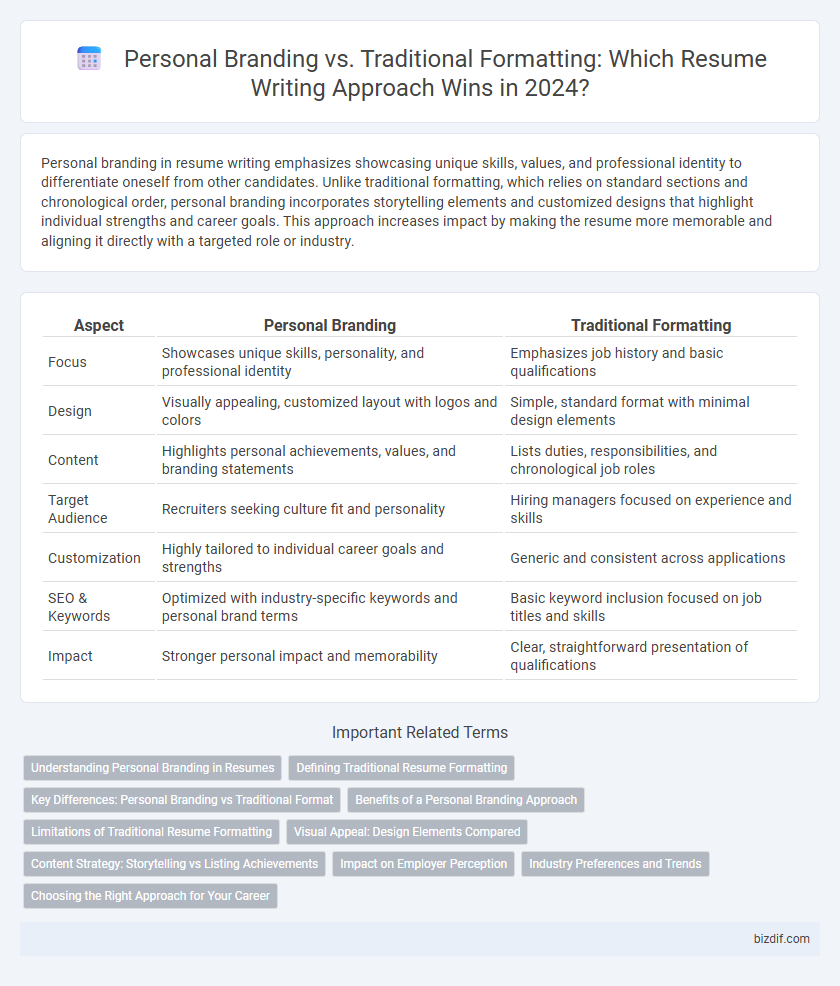Personal branding in resume writing emphasizes showcasing unique skills, values, and professional identity to differentiate oneself from other candidates. Unlike traditional formatting, which relies on standard sections and chronological order, personal branding incorporates storytelling elements and customized designs that highlight individual strengths and career goals. This approach increases impact by making the resume more memorable and aligning it directly with a targeted role or industry.
Table of Comparison
| Aspect | Personal Branding | Traditional Formatting |
|---|---|---|
| Focus | Showcases unique skills, personality, and professional identity | Emphasizes job history and basic qualifications |
| Design | Visually appealing, customized layout with logos and colors | Simple, standard format with minimal design elements |
| Content | Highlights personal achievements, values, and branding statements | Lists duties, responsibilities, and chronological job roles |
| Target Audience | Recruiters seeking culture fit and personality | Hiring managers focused on experience and skills |
| Customization | Highly tailored to individual career goals and strengths | Generic and consistent across applications |
| SEO & Keywords | Optimized with industry-specific keywords and personal brand terms | Basic keyword inclusion focused on job titles and skills |
| Impact | Stronger personal impact and memorability | Clear, straightforward presentation of qualifications |
Understanding Personal Branding in Resumes
Personal branding in resumes emphasizes showcasing unique skills, strengths, and values to create a memorable professional identity, contrasting with traditional formatting that focuses on chronological work history and standard bullet points. This approach integrates tailored summaries, strategic keywords, and visual elements to highlight individual expertise and career goals. Understanding personal branding helps job seekers differentiate themselves in competitive markets by aligning their resume content with target roles and industry trends.
Defining Traditional Resume Formatting
Traditional resume formatting emphasizes a chronological or functional layout, highlighting work experience, education, and skills in a clear, structured manner. This classic approach focuses on presenting career history and qualifications in a straightforward, easy-to-scan format preferred by many employers and applicant tracking systems (ATS). Traditional resumes prioritize uniformity and professionalism, using standard fonts, bullet points, and clear section headings to ensure readability and relevance.
Key Differences: Personal Branding vs Traditional Format
Personal branding in resume writing emphasizes showcasing unique skills, achievements, and personality to create a memorable impression, while traditional formatting follows a standardized structure focused on chronological job history. Personal branding integrates customized design elements, targeted keywords, and storytelling to highlight individual value, contrasting with the conventional format's reliance on clear, uniform sections like objective, experience, and education. This approach increases visibility in applicant tracking systems (ATS) and appeals directly to hiring managers seeking cultural fit and innovation.
Benefits of a Personal Branding Approach
A personal branding approach in resume writing highlights unique skills, values, and professional identity, making candidates more memorable to employers. This method enhances visibility in applicant tracking systems through tailored keywords aligned with industry trends. Unlike traditional formatting, personal branding fosters deeper connections by showcasing authenticity and career achievements that resonate with company culture.
Limitations of Traditional Resume Formatting
Traditional resume formatting often restricts personalization and fails to highlight unique professional identities, relying heavily on rigid structures such as chronological or functional layouts. These formats limit the ability to incorporate dynamic elements like personal branding statements, keywords for applicant tracking systems (ATS), and multimedia links, reducing overall impact. Consequently, candidates might miss opportunities to differentiate themselves and fully communicate their value to recruiters.
Visual Appeal: Design Elements Compared
Personal branding in resume writing emphasizes unique design elements that highlight individuality through custom color schemes, personalized logos, and modern typography. Traditional formatting relies on standardized layouts and classic fonts prioritizing clarity and professionalism over visual innovation. Effective resume design balances aesthetic appeal with readability to capture recruiters' attention while conveying qualifications efficiently.
Content Strategy: Storytelling vs Listing Achievements
Personal branding in resume writing emphasizes storytelling, weaving career experiences into a cohesive narrative that highlights unique skills and values, which resonates more deeply with employers. Traditional formatting focuses on listing achievements and job duties in a rigid, chronological order, often lacking emotional engagement. A content strategy centered on storytelling creates a memorable personal brand, showcasing impact and growth rather than just responsibilities.
Impact on Employer Perception
Personal branding in resume writing leverages tailored narratives and unique value propositions, significantly enhancing employer perception by showcasing authenticity and expertise. Traditional formatting emphasizes standardized layouts and concise job descriptions, which may fail to capture individuality or strategic impact. Employers increasingly favor resumes that integrate personal branding elements, as they better communicate a candidate's potential for cultural fit and innovative contributions.
Industry Preferences and Trends
Industry preferences increasingly favor personal branding over traditional formatting in resumes, emphasizing unique professional identity and storytelling to capture employer attention. Trends show recruiters prioritize customized resumes that highlight skills and achievements aligned with company values rather than generic, template-based formats. Leveraging personal branding techniques such as compelling summaries, consistent visual themes, and strategic keywords boosts visibility in applicant tracking systems and enhances overall candidate appeal.
Choosing the Right Approach for Your Career
Personal branding in resume writing emphasizes showcasing unique skills, values, and personality traits to create a distinct professional identity, enhancing visibility in competitive job markets. Traditional formatting prioritizes clear, structured presentation of experience, education, and skills, catering to Applicant Tracking Systems (ATS) and recruiters' expectations. Selecting the right approach depends on your industry, career goals, and whether you aim to highlight creativity or align with conventional hiring processes.
Personal branding vs Traditional formatting Infographic

 bizdif.com
bizdif.com